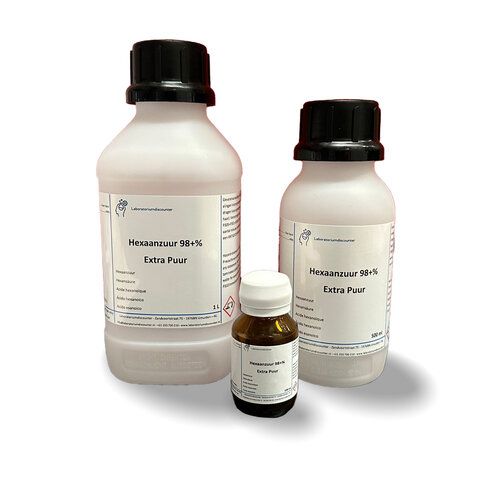Verzending 24–48 u • Levering in de hele EU • Veilige chemieverpakking
Hexanoic Acid 98+% Extra Pure 5L
SKU HXZ83.4
€ 164,50
In stock
1
Save this product for later
Hexanoic Acid 98+% Extra Pure 5L
Product Details
CAS number: 142-62-1
Chemical formulas: C₆H₁₂O₂
Molar mass g/mol: 116,16 g/mol
Density g/cm³: 0,93 g/cm³
Boiling point °C: 205 °C
Melting point °C: -4 °C
Flash point °C: 116 °C
UN number: 2829v
Packing group: 8 III
What is Hexanoic Acid?
Caproic acid, also known as hexanoic acid, is a saturated fatty acid with the chemical formula C6H12O2. It is named hexanoic acid because of the six carbon atoms in its molecule. Its structural formula is C6H12O2. Caproic acid occurs in certain natural sources, such as coconut oil and goat’s milk, and gives these substances their characteristic (unpleasant) odor and taste. It is also used in the food industry and cosmetics because of its aroma. Sometimes it is used as a flavoring in food products, and it is also used in the production of esters for fragrances and flavorings.
What is hexanoic acid used for?
Caproic acid has various applications in different industries due to its properties and aroma. Some applications of caproic acid:
Food industry: Caproic acid is sometimes used as a natural flavoring in food products. It can enhance the taste of certain food items and is often used in flavorings for dairy products such as cheese.
Cosmetics and perfumery: Because of its odor, caproic acid or its ester is sometimes used in cosmetic products and perfumes. It can be used in various cosmetic formulations, including lotions, creams, and soaps, to add a pleasant scent.
Pharmaceutical industry: In some pharmaceutical preparations, caproic acid is used as a component due to its antimicrobial properties. It can be used in medicines for skin treatment and antimicrobial ointments. Please note that this caproic acid is not certified for this purpose and must not be used for it.
Chemical industry: Caproic acid is a precursor for the production of various chemical compounds. For example, it can be converted into caproic acid esters, which are used as fragrance and flavoring agents in food and perfumes.
Animal feed: Caproic acid can be added to animal feed as a nutritional additive to improve the taste and smell of feed, making it more attractive to animals.
Chemical research laboratories: In laboratory environments, caproic acid can be used as a reagent or standard for analytical chemistry and spectroscopy.
Industrial applications: Sometimes caproic acid is used in industrial processes, such as in the production of plastics, plasticizers, and lubricants, although this occurs less frequently than with some other acids.
Other applications: Hexanoic acid is sometimes used in combination with ammonium bicarbonate and lactic acid to repel mosquitoes.
How is Hexanoic Acid made?
Hexanoic acid, also known as caproic acid, is usually produced by oxidizing hexanol, an alcohol with six carbon atoms. This process involves adding oxygen to hexanol, often using an oxidizing agent such as potassium permanganate (KMnO4) or air. A catalyst, usually a metal such as cobalt, manganese, or copper, can be used to speed up the reaction.
After the oxidation reaction, the reaction mixture is separated to isolate hexanoic acid. Impurities and by-products are removed, and the hexanoic acid can be further purified by distillation or other purification methods.
Finally, the caproic acid can be concentrated to the desired concentration, depending on the intended use. The production process may vary depending on the manufacturer and the specifications for purity and concentration.
Is hexanoic acid dangerous?
Caproic acid, also known as hexanoic acid, is generally not very dangerous to human health when used in accordance with normal safety regulations and in usual applications. It is a naturally occurring fatty acid that occurs in small amounts in foods such as coconut oil and goat’s milk, and it is often used in the food industry as a flavoring and in the cosmetics industry as a fragrance.
However, there are some important considerations:
Irritation: Like many other acids, caproic acid can cause irritation of the skin and mucous membranes when used in concentrated form. Contact with the skin may lead to redness, itching, or a burning sensation.
Inhalation: Inhalation of vapors or aerosols of caproic acid can cause irritation of the respiratory tract, so it is important to work in a well-ventilated area when handling concentrated caproic acid solutions.
Oral use: In small amounts, as found in food, caproic acid is safe for consumption. However, in concentrated form it can cause stomach discomfort and should be avoided.
Chemical flammability: Caproic acid itself is not flammable, but it can become flammable in the presence of ignition sources.
It is always important to follow the safety instructions and guidelines provided by manufacturers of products containing caproic acid. If you plan to use caproic acid in a laboratory or industrial environment, it is advisable to wear appropriate personal protective equipment and follow safety regulations to minimize possible hazards.
How should I best store hexanoic acid?
Store caproic acid in an airtight container in a cool, dark, and dry place, preferably at temperatures below 25°C. Ensure that the container is tightly closed to keep out moisture and light. Clearly label the container and avoid contact with incompatible substances. Periodically inspect for leakage or deterioration and keep it out of reach of children and pets.
Display prices in:EUR

